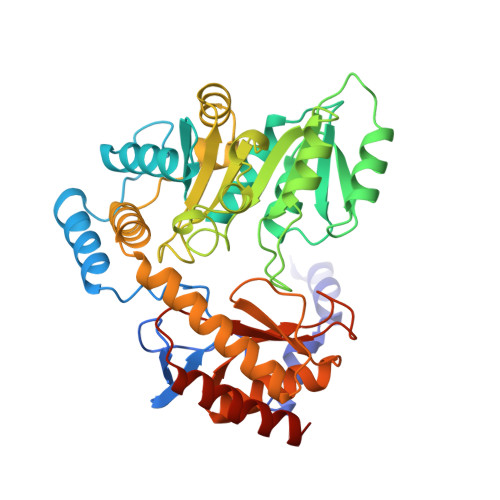Structural Insights into the Enzymatic Mechanism of Serine Palmitoyltransferase from Sphingobacterium multivorum
Ikushiro, H., Islam, M.M., Okamoto, A., Hoseki, J., Murakawa, T., Fujii, S., Miyahara, I., Hayashi, H.(2009) J Biochem 146: 549-562
- PubMed: 19564159
- DOI: https://doi.org/10.1093/jb/mvp100
- Primary Citation of Related Structures:
3A2B - PubMed Abstract:
Serine palmitoyltransferase (SPT) is a key enzyme of sphingolipid biosynthesis and catalyses the pyridoxal 5'-phosphate (PLP)-dependent decarboxylative condensation reaction of l-serine with palmitoyl-CoA to generate 3-ketodihydrosphingosine. The crystal structure of SPT from Sphingobacterium multivorum GTC97 complexed with l-serine was determined at 2.3 A resolution. The electron density map showed the Schiff base formation between l-serine and PLP in the crystal. Because of the hydrogen bond formation with His138, the orientation of the Calpha-H bond of the PLP-l-serine aldimine was not perpendicular to the PLP-Schiff base plane. This conformation is unfavourable for the alpha-proton abstraction by Lys244 and the reaction is expected to stop at the PLP-l-serine aldimine. Structural modelling of the following intermediates indicated that His138 changes its hydrogen bond partner from the carboxyl group of l-serine to the carbonyl group of palmitoyl-CoA upon the binding of palmitoyl-CoA, making the l-serine Calpha-H bond perpendicular to the PLP-Schiff base plane. These crystal and model structures well explained the observations on bacterial SPTs that the alpha-deprotonation of l-serine occurs only in the presence of palmitoyl-CoA. This study provides the structural evidence that directly supports our proposed mechanism of the substrate synergism in the SPT reaction.
Organizational Affiliation:
Department of Biochemistry, Osaka Medical College, Takatsuki, Osaka 569-8686, Japan. ikushiro@art.osaka-med.ac.jp
















